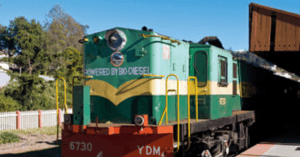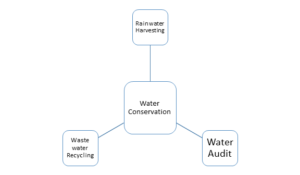Indian Railways – Victim, Contributor or Opportunity?

What if an organization consumed 365 billion litres of water and 18 billion kwh of electricity in a year?
Are the Indian Railways a victim of, contributor to, or opportunity for the environment?
The Indian Railways
What if an organization consumed 365 billion litres of water and 18 billion kwh of electricity in a year?
Indian Railways (IR) is the third largest rail network in the world with 66,000 route kilometres. It is a state-owned, single management enterprise, and unlike some of OECD countries, the most preferred long-distance mode of transport for ordinary citizens. 21,000 trains run every day, making IR one of the largest consumers of electricity and fuel in India.[1]
A victim of climate change?
Studies by the Indian Meteorological Department show that increasing pollution and emissions have resulted in an increase in fog and its density during winters in India[2]. Fog frequently result in delays and cancellations of trains and flights.[3] This causes losses to IR, problems with managing changing schedules, and hassles to passengers.
Power shortage is common during Indian summers. This has led to blackouts, when the railway service get interrupted for hours.[4] With increasing temperatures due to global warming, the need for air-conditioning and subsequent demand for electricity would most likely outstrip supply even further. Per a US EPA report[5], if a nation’s climate becomes warmer by 1.8 degrees F, demand for energy for cooling purposes is projected to go up by 5-20%.
Further, hundreds of miles of railway lines around India’s coasts are becoming increasingly vulnerable to waves, storms, and landslides, which are often attributed to climate pollution. Following such damage, lines usually need to be closed for weeks before normal operations can resume. Both the closure and the restoration of these lines incur significant costs[6].
A contributor to climate change?
Any transport organization serving 23 million passengers daily is bound to have major impact on the environment. IR accounts for 1.8% of India’s total power consumption. In 2014-15, it consumed 2.78 billion litres of diesel with an annual fuel bill of around 2.2 trillion USD. Most of this diesel is currently produced by burning fossil fuels, which in turn is a major contributor to global warming. IR is also a key consumer of water, consuming 1,000 million liters daily.
Scale of Operations – Opportunity
While the scale of its operations make IR a contributor to climate change, it also offers a massive scope for change. With 8,000 railway stations and over a million acres of land, there are abundant opportunities for sustainable environment practices.[7]
Some of the key steps taken by IR towards energy conservation are:
- Use of Alternative Fuel and Renewable Sources of Energy is being given high priority. An initiative to procure bio-diesel directly for 5% blending with High Speed Diesel Oil would reduce reliance on traditional fossil fuels. Also, pure diesel based motive power systems are proposed to be converted into partially CNG powered vehicles[8].
- Afforestation is being scaled up through ‘Green India Mission’ by boundary plantation alongside railway tracks and by planting trees on unutilized land.
- Solar Energy is being promoted by installing solar panels on rooftops of major stations. Rail wagons with solar panels on rooftops are already in pilot run while construction is ongoing for the first solar power plant dedicated to IR.[9]
- Major railway stations are being equipped with LED lights, which can cut electricity consumption by up to 70%.
- Electricity generation through waste has also started. Two such plants are being set up in New Delhi and Jaipur on pilot basis.
- Unutilized land is being used to install wind mills, which generates surplus power.[10]
Steps taken towards water conservation are:
- Rain Water Harvesting has now been made mandatory in all new railway projects.
- Water audit is being undertaken to assess annual consumption and plug any wastage thereof.
- To reduce the demand for fresh water, waste water recycling plants are being planned at major water consumption centers. This would also make stations self-sustainable and reduce the water bill.
Conclusion
Despite being a state-owned organization with massive scale and extremely complex operations, the Indian Railways has managed to come up with new and unique applications of its existing resources to combat global warming and climate change. When environment-friendly initiatives get implemented by the regulator itself, the multiplier effect on the general population is significant.
Word count : 777 words
[1] Environmental Sustainability – Role of Indian Railways 2015-16 – Indian Railways, Government of India
[2] Micro-climatic study and trend analysis of fog characteristics at IGI airport New Delhi using hourly data – Jenami RK, India Meteorological Department
[3] www.indianexpress.com/article/cities/delhi/delhi-fog-35-trains-cancelled-14-delayed
[4] ‘Climate Change and India- Vulnerability Assessment and Adaptation’ – Universities Press
[5] www.epa.gov/climate-impacts/climate-impacts-energy
[6] ‘On the Edge’ – Professor Robert Duck, University of Dundee
[7] articles.economictimes.indiatimes.com/2012-05-21/news/31800910_1_vacant-railway-land-acres-rail-land-development-authority
[8] www.mythicalindia.com/features-page/10-initiatives-which-prove-that-indian-railway-is-serious-about-its-business-of-going-green/#
[9] Rail Budget 2016-17, Ministry of Railways, Government of India
[10] http://mythicalindia.com/features-page/10-initiatives-which-prove-that-indian-railway-is-serious-about-its-business-of-going-green








Good job bringing out how an organization can be a victim and contributor to climate change. This relates to the class we had on the IKEA case. IR may be contributing to climate change by consuming copious amounts of water and electricity to serve its passengers, but at the same time, the organization is finding opportunities to deliver its services in a cleaner way. This is valuable in that IR is setting a high standard for itself while delivering services that cannot be compromised or reduced. Passengers will require this scale of services regardless and as India continues to develop, the pressure placed on IR to run more trains at greater capacity will only increase. IR might as well pave the path in employing clean standards compared to assessing its negative role as a contributor to climate change.
Fair point Ranj. And since IR has such high amounts of fuel and water consumption and owns so much land, the effect of its initiatives will hopefully be significant in magnitude.
I like your ideas for making Indian Railways more sustainable. Another big one is railway electrification, which gets trains off of diesel engines. The question then becomes — where does the electricity come from. Electricity produced by coal-fired power plants is just as bad for the environment as using diesel engines. If IR contracted with renewable energy producers for power produced from wind/solar, then it could create a carbon-neutral rail network.
Agree with you Alex. In fact they are already taking measures such as using bio-diesel, solar energy, and wind energy, as I had mentioned in my post. I believe they should keep pushing on using these renewable energy sources.
IR seems like it has many great ideas for making its existing operations more efficient, though perhaps the biggest step it can take to reduce India’s GHG emissions is to expand very quickly. See Table 4 on pg. 6 of this article (http://wgbis.ces.iisc.ernet.in/energy/paper/IISc_Emissions_from_Indias_Transport_sector/TVR_emission2009.pdf) which finds that CO2 emissions from the railways sector in India is a fraction of that from road transportation. I think that raises interesting trade-offs for IR about whether it’s best to i) make its operations more climate friendly, at the risk of making incremental expansion more difficult or ii) focus on rapid expansion, even without improving the environmental impact of its operations, in the hope they displace even less sustainable alternatives to rail transportation.
And to Alex’s suggestion: electrification is an interesting approach and one that China has followed (http://business.rediff.com/slide-show/2010/jun/21/slide-show-1-what-india-can-learn-from-chinese-railway.htm). It may have benefits even if electricity generation isn’t done more cleanly than diesel powered trains by reducing particulate emission along the train’s journeys with possible worse effects on civilian health than the similar quantity of emissions from a more isolated power plant. This seems to raise another interesting tension between prioritizing i) local environmental consequences of fossil fuels vs. ii) reducing GHG emissions generally.
That is always an interesting dilemma. I believe the answers lies somewhere in the middle – let railways grow and serve people more, while it takes environment-friendly initiatives which do not necessarily hurt its growth.
This is an interesting question that you pose and in my opinion, I think there is a huge opportunity for Indian Railways to play their part in sustainability. Taking from RG’s comment, I think Indian Railways should further expand and improve their network which will go a long way in promoting a better mode of transport. Taking the example of Mumbai, it is clear that the railways play a pivotal role in mobilizing the 20 million odd people of the city every day. While trains are still considered the most on time and reliable mode of transport in Mumbai, they are always running over their loading capacity, thereby making the experience extremely uncomfortable which leads to locals opting for road transport. By investing in better railways infrastructure (and better public transport system), the city will reap huge benefits of added convenience, reduced congestion and improved environment.
While its important that Indian Railways are looking at ways to improve sustainability through energy and water efficiency I find it comical that they have not addressed one of their most direct impacts – that of human waste. Trains bathrooms do not have tanks or ways of storing and then correctly disposing of waste. It is simply an open hole where waste goes directly onto the tracks. Given the millions of people who use the train daily across India this has a major impact on the environment and on health.
This impact is directly within their control and would certainly improve customer experience. Whats stopping them from tackling this first?